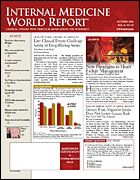Publication
Article
Internal Medicine World Report
Older People Beating the Odds With Aids Therapy
Author(s):
TORONTO—An examination of large databases has revealed that older people with HIV infection are far more likely to have adverse events from antiretroviral therapy than younger people, but older individuals are nonetheless much more likely to adhere to the prescribed therapeutic regimen and thus achieve a better response.
Researchers at Kaiser Permanente Northern California in Oakland tracked up to 6 years of data on comorbidities, side effects, and adherence in a group of 5079 HIV-positive patients who started highly active antiretroviral treatment (HAART) between 1995 and 2004. All were taking at least 3 antiretroviral agents.
Patients were divided into 3 groups based on their age when they started antiretroviral therapy: (1) ages 18 to 39 (n = 2259); (2) ages 40 to 49 (n = 1834); and (3) ages ≥50 years (n = 997).
The oldest age-group had higher rates of elevated total cholesterol and low-density lipoprotein cholesterol (34% vs 21% in the 18-39 group and 26.4% in the 40-49 group; P = .001); significantly higher rates of elevated blood glucose (14.4% vs 6% and 11.4%, respectively; P <.001); abnormally low hemoglobin (10.2% vs 6.9% and 6.9%, respectively; P = .033); and elevated creatinine (8.3% vs 3.2% and 5.8%, respectively; P <.001).
There were, however, no significant differences between the 3 groups in platelet or neutrophil counts or in liver enzyme levels.
“Lipid abnormalities, anemia, and renal and glucose abnormalities are known side effects of antiretroviral therapy, and hence it was not surprising that some were more common in older patients. But this had not been systematically studied in the context of HIV infection,” commented lead investigator Michael J. Silverberg, PhD, MPH, epidemiologist/research scientist, HIV Initiative, Division of Research, Kaiser Permanente. He added that “it is hard to say how our rates for these abnormalities compare with other groups/populations, since it is not something we have directly evaluated.”
Despite the higher incidence of adverse events, the oldest age-group had the highest rates of adherence.
During the first year after therapy initiation, 38.8% of the oldest group (≥50 years) had optimal adherence (taking at least 95% of their medications) and 65.4% had good adherence (defined as taking at least 75% of their medications).
In contrast, 30.2% of the youngest group (18-39 years) and 33.4% of the middle group (40-49 years) had optimal adherence during the first year of treatment. The respective percentages for good adherence were 59.1% and 61.2% (P <.001).
The oldest age-group was also 15% more likely to have suppressed their HIV-1 RNA levels to <500 copies/mL than were the younger age-groups (P = .005), a finding that was attributed entirely to the higher adherence rates in the former.
Finally, although patients ≥50 years had less rapid increases in CD4+ T-cell counts in the first year after beginning HAART, their better adherence translated into mean CD4+T-cell levels that were similar to those in the 2 younger age-groups at the end of 3 years of treatment.





